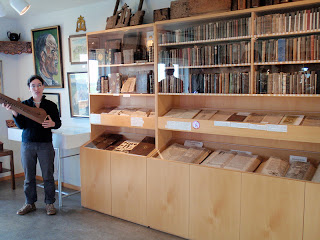As we made our way east from Sellfoss, we made our way thru some of the highlights of Southern Iceland. As we drove along the coast, we had a decent view of the Westman Islands, located off the southern coast.
Our first stop was at the farm that sits in front of the Eyjafjallajökull volcano. This was the volcano that shut down air travel to and in Europe for two weeks back in 2010. I shook my fist at volcano to express my anger at my cancelled trips.
Just beyond Eyjafjallajökull likes Katla, another volcano, which usually erupts shortly after the former. Many people think that when it does, it will put the chaos of last year to shame. Katla has the potential to really wreak havoc on the planet.
After leaving Eyjafjallajökull, we made our way to Mýrdalsjökull, Icelandic for "mire valley of the glacier". The top of the glacier is just under 5,000 feet and covers the Katla volcano.
One thing that was surprising was how quickly the glacier has retreated in recent years. Steini told us that the point where we took this picture was the end of the glacier only 20 years ago. The warming of the planet has caused the ice to melt at a faster pace.
After a brief stop in Vík where I purchased a woolen cap, we made our way to the beach head at Dyrhólaey. It's the southern most part of Iceland and is a popular nesting area for puffins during the summer time. By the time we got there in October they had already moved on though.
The name Dyrhólaey means "door hole" and gets it's name from the hole created by the erosion of the cliff. A stunt pilot named Tommy Taylor flew thru the arch as part of a daredevil act.
The first waterfall we visited that day was Skógafoss. It's one of the larger falls in the country, with a width of over 82 feet and a drop of over 200 feet. Because of the height of the falls and the direction it faces, on clear days a rainbow is visible.
According to legend, a Viking by the name of Þrasi Þórólfsson buried a treasure in a cave behind the waterfall. A local boy found the chest years later, but was only able to grasp the ring on the side of the chest before it disappeared again
We left Skógafoss and made our way towards the town of Skógar, which means "forrest" in Icelandic. The town has a population of roughly 25 and the main attraction is the folk museum.
Almost the entire collection was amassed by one man, named Þórður Tómasson. Now in his 90's, Þórður started collecting when he was 14 years old.
He was a curmudgeonly old man who would enter and leave at various points in our tour and either give us a lecture or sit down and play us a song.
At the end of the tour, we joined Þórður at the old church and he led us in the singing of several hymns.
The final stop of the day was to Seljalandsfoss. It gained some notoriety after appearing as the starting point of the Amazing Race in season six. Because of the unique position, it is possible to walk behind the falls, which fall over 200 feet from the top.
As we were leaving Seljalandsfoss, the sun was setting, creating a spectacular view.






























No comments:
Post a Comment